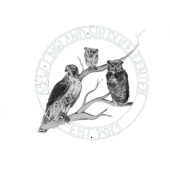Sir Isaac Newton stated “Every action has an equal and opposite reaction”. That is proving to be true as we quarantine during this Covid-19 pandemic. As more people are staying indoors, more animals are filling up the spaces that are now vacant. They have become emboldened to explore new opportunities, and this has led to some surprising, and positive changes for the environment.
At the wildlife center, in our own yard, we are being visited by woodchucks, who we rarely see, and an increase in red-tailed hawks, turkeys and geese. We have a pair of swans on our pond. I have never seen swans on our pond. Because we have very few people on site, especially outdoors, the animals now feel safer to settle in.
With fewer people out, and fewer cars on the road, the earth has benefitted in so many ways. The air is cleaner, and the water is cleaner. The streets and towns are deserted and the animals are filling the void. Fewer cruise ships and container ships are in the oceans so Humpback whales and their calves moving north have had a less treacherous trip. For the first time, a Blue Whale was seen off the coast of Truro.
Around the world, urban animals and more elusive wildlife are openly roaming the empty streets. Coyotes, foxes, raccoons, deer, and bear are seen searching out food . In Southern California there was a photo of a coyote and badger wandering together. A most unlikely pair. Alligators are sunning on the empty beaches in South Carolina. Mountain lions are coming into Boulder Colorado.
Sea turtles are flourishing in some areas. Leatherback turtle nesting sites have increased on the east coast of Florida. Fewer turtles are being killed by boat strikes and nests are not trampled on by beach goers. Hatchlings will not become disoriented when they head to the water by the light pollution that is usually near the beach. In Thailand, the beaches bare of humans have seen the highest number of leatherback turtle nests ever recorded. In Brazil, sea turtles also nest without disturbance and harassment.
As we go from country to country we see amazing sights. In Venice, the canals have clear water filled with fish and even jellyfish. Two months ago, they were filled with waste, and foul-smelling. Wild boar are now seen walking the streets of Barcelona. Mountain goats have overtaken a town in Wales and can be seen munching on the flowers in window boxes. Buffalo roam on empty highways in India. In Italy, goats and sheep visit towns without any shepherds tending to the flocks. At our National Parks in the US, there are far fewer wildlife mortalities due to vehicles, which in tourist season is a huge problem.
Not all the animals have been peaceful. Some animals rely on humans, especially tourists, for their food and they are not getting what they are used to. Deer in Japan who are used to being in the city streets and getting fed are becoming aggressive. In Thailand, local monkeys generally fed by tourists have mobbed the town and are fighting and destroying property.
So, what happens when the quarantine is over and people are out and about. How will this affect the wildlife? Unfortunately, there will once again be a fight over habitat. The animals had it first, the humans took it, the animals saw an opportunity to move back in a bit, and eventually the humans will take it back to the detriment of the wildlife. There will be clashes, and animals will be hurt, re-located, considered threats, and even killed.
An ideal scenario would be one where there is a learned peaceful co-existence based on mutual respect. A way could be found to continue to improve the changes made to air and water quality as we get back to our daily lives. We could drive less. We could pollute less. We could learn about the specific needs of wildlife in our area and strive to meet those to keep a healthy population. The Wildlife Center is available to answer any questions you may have regarding wildlife in your area.
The quarantine has been an awakening on many levels. We have learned we can live with fewer “things”. That we can re-use. Eat less meat. Grow our own food. If continued, these lessons will all help the environment, our wildlife, and most of all, ourselves.

Recent Comments